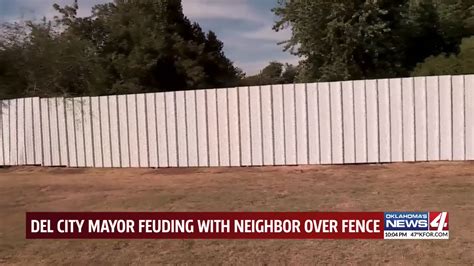
A property dispute in Washington state has escalated into a full-blown neighbor feud after a survey revealed a property line discrepancy, prompting a 39-year-old homeowner to erect a fence that his neighbor claims encroaches on their land.
Neighbor Feud Erupts Over Property Line Dispute in Washington State
BELLEVUE, WA – A seemingly amicable neighborly relationship in Bellevue, Washington, has soured dramatically following a property survey that revealed a significant discrepancy in the established property lines. The dispute centers around a contested piece of land, leading one homeowner, a 39-year-old identified as only “Joey,” to construct a fence along what he believes to be the correct boundary, an action that his neighbor, only named as “Jim,” claims is an illegal land grab. The conflict has not only fractured the peace of the neighborhood but also raised broader questions about property rights, surveying accuracy, and the legal recourse available to homeowners in such situations.
The genesis of the feud can be traced back to Joey’s decision to commission a professional survey of his property. According to Joey, the survey results indicated that the existing fence line, which had been in place for several years, was incorrectly positioned, effectively ceding a portion of his land to his neighbor, Jim. “I was shocked,” Joey stated in an interview. “The survey clearly showed that the fence was not on the property line. It was several feet inside my property.” Armed with this information, Joey approached Jim to discuss the findings and propose a solution.
However, the conversation did not go as planned. Jim disputed the accuracy of the survey and refused to acknowledge Joey’s claim to the contested land. “He wouldn’t even entertain the idea that the survey could be right,” Joey explained. “He insisted that the fence had been there for years and that the property line was where he thought it was.” With negotiations at an impasse, Joey decided to take matters into his own hands and construct a new fence along the surveyed property line.
This decision proved to be the catalyst for the escalation of the conflict. Jim immediately objected to the construction of the new fence, arguing that it encroached on his property and violated local zoning regulations. He has since accused Joey of acting unilaterally and without proper authorization. The situation has become increasingly tense, with both parties reportedly engaging in heated arguments and legal threats.
According to Jim, the original fence had been in place for an extended period, leading him to believe that it accurately represented the property line. He claims that Joey’s actions are disruptive and unwarranted, accusing him of trying to seize land that rightfully belongs to him. “This has been a nightmare,” Jim lamented. “I’ve lived here for years, and we’ve always been good neighbors. Now, this guy comes along and tries to take my land. It’s just not right.”
The dispute highlights the complexities and potential pitfalls of property line disagreements. While surveys are generally considered to be reliable indicators of property boundaries, they are not infallible. Errors can occur due to outdated records, inaccurate measurements, or conflicting interpretations of legal descriptions. Furthermore, the legal concept of “adverse possession,” also known as “squatter’s rights,” can further complicate matters. Adverse possession allows a person to claim ownership of property that they have occupied openly, continuously, and exclusively for a specified period, even if they do not have legal title.
In Washington state, the statutory period for adverse possession is ten years. This means that if Jim can demonstrate that he has openly and continuously possessed the disputed land for at least ten years, he may have a legal claim to ownership, regardless of the survey results. However, establishing adverse possession requires meeting a strict legal standard, and the burden of proof rests on the person making the claim.
The Bellevue property dispute is now headed for a potential legal showdown. Jim has reportedly consulted with an attorney and is considering filing a lawsuit to challenge Joey’s actions and assert his claim to the contested land. Joey, on the other hand, maintains that he is acting within his legal rights and is prepared to defend his property.
The case underscores the importance of conducting thorough due diligence before purchasing property, including reviewing existing surveys, title documents, and local zoning regulations. It also highlights the need for clear and open communication between neighbors to resolve potential disputes amicably. In situations where disagreements arise, mediation or professional arbitration can often provide a less adversarial and more cost-effective means of reaching a resolution than litigation.
The outcome of the Bellevue neighbor feud remains uncertain. However, one thing is clear: the dispute serves as a cautionary tale about the potential for property line disagreements to escalate into protracted and costly legal battles. It also underscores the importance of respecting property rights, adhering to legal procedures, and seeking professional guidance when disputes arise. As the legal proceedings unfold, the residents of Bellevue will be watching closely, hoping for a resolution that restores peace and harmony to their neighborhood. The case also brings up the question of whose survey is correct, who will pay for the legal fees, and what are the possible resolutions for this case.
Further complicating matters:
Adding another layer to the complex situation, questions have arisen regarding the permitting process for the new fence. Local zoning ordinances often require property owners to obtain permits before constructing fences, particularly if they are located near property lines. It remains unclear whether Joey obtained the necessary permits before erecting the new fence, and any failure to comply with these regulations could result in fines or other penalties. Jim could leverage this issue to further delay the process, and cause Joey more expenses to resolve the issue.
According to the Bellevue Municipal Code, fences exceeding a certain height may also be subject to additional restrictions. The code also specifies setback requirements, which dictate how far a fence must be located from the property line. If the new fence violates these regulations, Joey may be required to modify or remove it. It’s important to note that setback requirements are set in place to ensure there is adequate space for public utilities, and right-of-ways.
This aspect of the dispute highlights the importance of understanding and complying with local zoning regulations before undertaking any construction project. Property owners are responsible for ensuring that their projects meet all applicable requirements, and failure to do so can result in significant legal and financial consequences.
The Impact on the Community:
The neighbor feud has not only affected Joey and Jim but has also had a ripple effect on the broader community. Other residents of the neighborhood have expressed concern about the escalating conflict and its potential impact on property values. Some neighbors have taken sides in the dispute, while others have tried to remain neutral.
The situation has also raised questions about the role of homeowners’ associations (HOAs) in resolving property disputes. While some HOAs have the authority to mediate disputes between residents, others may be limited in their ability to intervene. In this case, it is unclear whether the Bellevue neighborhood has an HOA and, if so, whether it has played any role in attempting to resolve the conflict.
Regardless of the specific circumstances, the neighbor feud serves as a reminder of the importance of maintaining positive relationships within the community. Open communication, mutual respect, and a willingness to compromise are essential for fostering a harmonious living environment. When disputes arise, seeking professional mediation or arbitration can often provide a more constructive and less adversarial approach to resolution than litigation.
The Role of Surveys in Property Disputes:
The Bellevue neighbor feud underscores the critical role that surveys play in defining property boundaries and preventing disputes. A survey is a precise measurement and mapping of a piece of land, conducted by a licensed surveyor. The survey results are typically recorded in a legal document, which can be used to establish the exact location of property lines, easements, and other features.
Surveys are essential for a variety of purposes, including:
- Establishing property boundaries: Surveys provide a definitive record of the location of property lines, which can help prevent disputes between neighbors.
- Identifying easements and rights-of-way: Surveys can identify any easements or rights-of-way that may affect a property, such as utility lines or access roads.
- Determining building setbacks: Surveys can be used to determine the required setbacks for buildings and other structures, ensuring compliance with local zoning regulations.
- Subdividing land: Surveys are required when subdividing land into smaller parcels, ensuring that each parcel meets all applicable requirements.
- Resolving boundary disputes: Surveys can be used to resolve existing boundary disputes, providing an objective and authoritative basis for determining the correct property lines.
When commissioning a survey, it is important to hire a licensed surveyor who is experienced in conducting surveys in the relevant jurisdiction. The surveyor should be provided with all available information about the property, including existing surveys, title documents, and any relevant legal descriptions. The surveyor should also be consulted about the specific purpose of the survey and any particular concerns or issues that need to be addressed.
The Legal Concept of Adverse Possession:
As mentioned earlier, the legal concept of adverse possession can play a significant role in property disputes. Adverse possession allows a person to claim ownership of property that they have occupied openly, continuously, and exclusively for a specified period, even if they do not have legal title.
To establish adverse possession, the claimant must demonstrate that their possession of the property meets the following requirements:
- Open and Notorious: The possession must be visible and obvious to the true owner, such that a reasonable person would be aware of the claimant’s presence on the property.
- Continuous: The possession must be uninterrupted for the statutory period, which varies by state. In Washington, the statutory period is ten years.
- Exclusive: The possession must be exclusive to the claimant, meaning that they cannot share possession with the true owner or the general public.
- Hostile: The possession must be hostile to the true owner’s title, meaning that the claimant must be asserting a claim of ownership that is inconsistent with the true owner’s rights.
- Actual: The claimant must physically occupy the property and use it in a manner consistent with ownership.
The requirements for establishing adverse possession are strict, and the burden of proof rests on the person making the claim. The claimant must provide clear and convincing evidence to support their claim.
In the Bellevue neighbor feud, Jim may attempt to assert a claim of adverse possession based on the fact that the original fence had been in place for an extended period. However, to succeed on this claim, he would need to demonstrate that his possession of the disputed land met all of the requirements for adverse possession for at least ten years.
Alternative Dispute Resolution:
Given the potential costs and complexities of litigation, alternative dispute resolution (ADR) methods can provide a more efficient and effective means of resolving property disputes. ADR methods include mediation and arbitration.
-
Mediation: Mediation is a process in which a neutral third party facilitates communication between the disputing parties and helps them reach a mutually agreeable resolution. The mediator does not have the power to impose a decision but rather assists the parties in exploring their options and finding common ground.
-
Arbitration: Arbitration is a process in which a neutral third party hears evidence and arguments from both sides and renders a binding decision. The arbitrator’s decision is typically enforceable in court.
ADR methods offer several advantages over litigation, including:
- Cost-effectiveness: ADR is typically less expensive than litigation.
- Speed: ADR is typically faster than litigation.
- Flexibility: ADR can be tailored to the specific needs of the parties.
- Confidentiality: ADR proceedings are typically confidential, whereas court proceedings are public record.
- Preservation of relationships: ADR can help preserve relationships between the disputing parties, whereas litigation can often damage those relationships.
In the Bellevue neighbor feud, mediation or arbitration could provide a more constructive and less adversarial approach to resolving the dispute than litigation. A neutral third party could help Joey and Jim understand each other’s perspectives and find a mutually agreeable solution that respects both of their property rights.
The Importance of Clear Communication and Documentation:
The Bellevue neighbor feud underscores the importance of clear communication and documentation in preventing and resolving property disputes. Property owners should communicate openly and honestly with their neighbors about any potential issues or concerns. They should also maintain thorough documentation of all relevant information, including surveys, title documents, zoning regulations, and communications with neighbors.
When disputes arise, it is important to document all interactions and agreements in writing. Written agreements can help prevent misunderstandings and provide a clear record of the parties’ intentions. In the event that a dispute cannot be resolved through negotiation, written documentation can be invaluable in presenting a case to a mediator, arbitrator, or court.
The Bellevue case serves as a reminder that proactive communication and documentation can go a long way in preventing and resolving property disputes. By taking these steps, property owners can protect their property rights and maintain positive relationships with their neighbors.
The Future of the Dispute:
As the Bellevue neighbor feud continues to unfold, the outcome remains uncertain. The parties may attempt to resolve the dispute through negotiation, mediation, or arbitration. Alternatively, the case may proceed to litigation, where a court will ultimately decide the matter.
Regardless of the specific course of events, the Bellevue neighbor feud serves as a cautionary tale about the potential for property line disagreements to escalate into protracted and costly legal battles. It also underscores the importance of respecting property rights, adhering to legal procedures, and seeking professional guidance when disputes arise. As the legal proceedings unfold, the residents of Bellevue will be watching closely, hoping for a resolution that restores peace and harmony to their neighborhood.
Property Values and Disclosure:
The ongoing dispute between Joey and Jim could potentially impact property values in the immediate vicinity. Prospective buyers might be hesitant to purchase homes near a property embroiled in such a visible and contentious disagreement. Real estate agents are typically required to disclose known disputes to potential buyers, which could further affect the marketability of the properties involved. This situation highlights the broader economic consequences that can arise from neighborly conflicts, extending beyond the immediate parties involved.
The Emotional Toll:
Beyond the legal and financial implications, the neighbor feud has undoubtedly taken a significant emotional toll on both Joey and Jim. The stress of dealing with a protracted dispute, the animosity between neighbors, and the uncertainty about the future can be emotionally draining. This situation underscores the importance of finding amicable resolutions to property disputes, not only to protect property rights but also to preserve the well-being of those involved. Mental health experts often recommend seeking support from friends, family, or therapists to cope with the emotional challenges associated with such conflicts.
Building Codes and Fence Regulations:
A crucial aspect of the dispute revolves around compliance with local building codes and fence regulations. The height, materials, and placement of the new fence must adhere to Bellevue’s specific ordinances. If the fence violates these regulations, Joey may be required to modify or remove it, regardless of the property line issue. Building permits are often required for fence construction, and failure to obtain the necessary permits can result in fines and legal action. This situation underscores the importance of thoroughly researching and complying with all local regulations before undertaking any construction project on a property. It is also important to consider the fence regulations because the fence is subject to HOA and neighborhood laws.
Title Insurance Implications:
Title insurance policies typically cover disputes arising from errors in property surveys or discrepancies in property lines. Both Joey and Jim should review their title insurance policies to determine if they provide coverage for the current situation. If the survey commissioned by Joey reveals a previously unknown defect in the property title, the title insurance company may be responsible for covering the costs of resolving the dispute, including legal fees and potential settlement payments. However, the extent of coverage can vary depending on the specific terms and conditions of the policy. It’s important to read the fine print to understand what is covered and what is not.
Community Mediation Services:
Many communities offer mediation services to help resolve disputes between neighbors. These services provide a neutral forum for parties to discuss their concerns and work towards a mutually agreeable solution. Community mediation can be a less expensive and more amicable alternative to litigation. Both Joey and Jim should consider utilizing community mediation services as a means of resolving their dispute without resorting to legal action. Community mediation services can help resolve the issue more efficiently, saving time and money.
FAQ:
-
What is the main issue in the Bellevue neighbor feud?
- The main issue is a property line dispute that arose after a survey commissioned by one homeowner, Joey, revealed that the existing fence line was incorrectly positioned, leading him to build a new fence that his neighbor, Jim, claims encroaches on his property.
-
What is adverse possession and how does it relate to this case?
- Adverse possession is a legal concept that allows a person to claim ownership of property they have occupied openly, continuously, and exclusively for a specified period (ten years in Washington state), even without legal title. Jim may attempt to claim adverse possession based on the original fence’s long-standing presence.
-
What are the potential legal consequences for Joey if the new fence violates local zoning regulations?
- If the new fence violates local zoning regulations regarding height, materials, or setback requirements, Joey may be required to modify or remove it and could face fines or other penalties from the city of Bellevue.
-
What alternative dispute resolution methods are available to Joey and Jim?
- Joey and Jim can consider mediation, where a neutral third party facilitates communication and helps them reach a mutually agreeable solution, or arbitration, where a neutral third party hears evidence and renders a binding decision. Also, the parties can consider community mediation.
-
How could this neighbor feud potentially impact property values in the area?
- The ongoing dispute could negatively impact property values in the immediate vicinity, as prospective buyers may be hesitant to purchase homes near a property embroiled in such a visible and contentious disagreement. Real estate agents are typically required to disclose known disputes to potential buyers, which could further affect the marketability of the properties involved.









